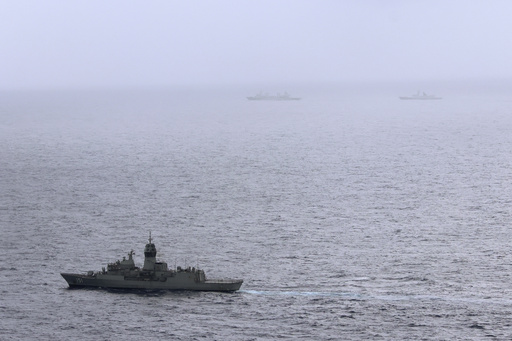
MELBOURNE, Australia — A recent incident involving commercial airliners over the Tasman Sea, which connects Australia and New Zealand, has raised safety concerns. Australian Defense Minister Richard Marles disclosed that the Chinese navy alerted the airlines about their live-fire exercise while the planes were in mid-air. This situation unfolded as three Chinese warships were conducting military exercises off the eastern coast of Australia.
Authorities in Australia were only made aware of the potential dangers posed by China’s military exercises when the airlines reported receiving a notification from the Chinese navy. Marles emphasized that Australia had not been directly informed by Beijing, noting, “To be clear, we weren’t notified by China.” Instead, the Chinese military broadcast an announcement regarding their live-fire intentions, which was picked up by the airlines flying overhead.
The warning from the Chinese warship prompted three flights from Sydney to alter their routes to avoid the location of the live-fire exercise. Airlines involved included Emirates, Qantas, and Virgin Australia. Each of these airlines chose not to provide comments regarding the situation. Marles mentioned that usually the Australian navy provides a notice of 12 to 24 hours ahead of such exercises, allowing airlines to appropriately adjust their flight plans.
Fortunately, the Australian defense authorities confirmed that none of the flights faced real danger, as they all successfully diverted. The three Chinese vessels participating in the exercises included the frigate Hengyang, the cruiser Zunyi, and the replenishment ship Weishanhu, engaging in exercises that reflect China’s efforts to assert freedom of navigation in international waters, a move that often irritates Beijing when conducted by Australian military forces in the South China Sea.
During a press briefing, the Chinese foreign ministry stated that the military drills were executed with safety, professionalism, and compliance to international law. Meanwhile, Australian officials indicated they were unsure if any live ammunition had actually been fired during the exercises. Prime Minister Anthony Albanese reassured the public that there was no immediate risk to either Australian or New Zealand assets from the Chinese operations.
Interestingly, New Zealand’s aviation authority chose not to issue any alerts about the situation. They acknowledged receiving information from Australia but did not elaborate on their decision-making process. Australian Foreign Minister Penny Wong indicated that she would address the air service disruptions in discussions with her Chinese counterpart at the G20 meeting currently taking place in South Africa.
Flight tracking services reported that several aircraft altered their routes to avoid the potential hazards over the waters between Australia and New Zealand. Air New Zealand stated that it adjusted its flight paths as necessary without any issues impacting its operations. Australian and New Zealand military ships, along with P-8 Poseidon surveillance planes, have been monitoring the activities of the Chinese warships for several days.
The recent maneuvers by the Chinese vessels, which are seldom seen so far south, are viewed as a demonstration of China’s increasing naval strength. Some officials, like Captain Steve Cornell of the Australian and International Pilots Association, criticized the Chinese military for conducting their exercises in such a heavily trafficked air corridor, suggesting they could have chosen a location with less impact on civilian air traffic. Nonetheless, Albanese stressed that the exercises were lawful and occurred in international waters, well outside Australia’s exclusive economic zone.

